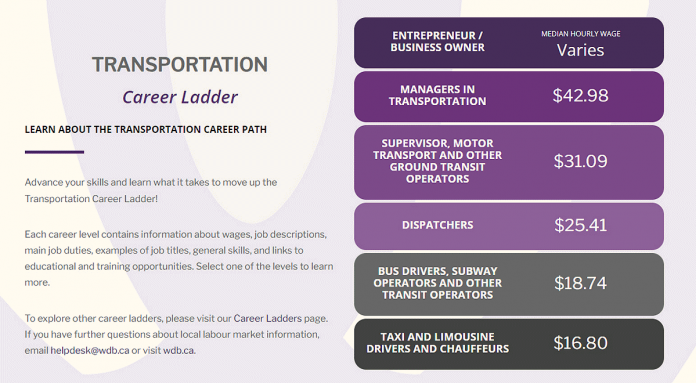
The Workforce Development Board (WDB) has unveiled the latest in its series of online ‘career ladders’ — an interactive tool that helps workers and job seekers understand the path from an entry-level position in their chosen profession to progressively more senior positions.
The new Transportation Career Ladder — available at www.wdb.ca/transportation-career-ladder — lists six career levels in the transportation sector, starting with taxi and limousine drivers and chauffeurs and continuing with bus and subway operators and other transit operators, dispatchers, supervisors of motor transport and other ground transit operators, managers in transportation and, at the top of the ladder, entrepreneurs and business owners.
Each career level includes hourly wages (including low, median, and high), a description of the career level and main job duties, skills needed, sample job titles, and education and training required. Each career level also includes a link to currently available positions listed on WDB’s Local Jobs Hub.

Recognizing the importance of transportation to the tourism industry, the Transportation Career Ladder has been funded by Regional Tourism Organization 8 (RTO8) with funding received from the Ontario Ministry of Tourism, Culture and Sport.
The Transportation Career Ladder joins WDB’s other seven career ladders at www.wdb.ca/career-ladders, including accommodation, agriculture, construction, food service, manufacturing, retail, and arts, entertainment and recreation.
As manager of employment services with Employment Planning and Counselling (EPC) Peterborough, Nancy Thompson is most impressed by the ease of information navigation that each career ladder features.
“Having this information right at our clients’ fingertips is just amazing for them,” she enthuses. “It makes it so much easier to do the research because everything’s right there. It’s like being served everything you need on a silver platter.”
Thompson adds that the career ladders can greatly benefit workers and job seekers, who otherwise would have to spend a lot of time and effort to find the same information themselves.
“I googled something the other day and it literally said there were 999,999 links on the subject,” she recalls. “With career ladders, you don’t have to manoeuvre your way through irrelevant information or ads. The career ladder provides only the relevant information you need to move forward. It’s invaluable.”

WDB’s Chief Executive Officer Jennifer Lamantia couldn’t agree more, describing the benefit of being able to see the available local job positions at each level of the Transportation Career Ladder.
“We hear frequently that people are frustrated when they don’t know what an entry position could lead to. When you click the link for job posts for managers in transportation, you’ll see all the active job postings today for transportation managers in the region. So if you start out in your transportation career as a taxi or limousine or Uber driver, you’ll see the potential to grow into a management position locally if you choose to do so.”
Thompson echoes that sentiment.
“Someone might think ‘I’m just an Uber driver’ and not realize where they could go from there,” she says. “The career ladder tells them where they could go while also providing information on what they need to get there.”
Lamantia is quick to note the attractive design and ease of use of each career ladder, crediting Ryan Lowe of Peterborough-based Butter Web Design. The career ladders are mobile friendly and provide the same experience on a smartphone or tablet as on a laptop or desktop.
“People like the format,” she says. “The other piece that’s really powerful is that it integrates with our online job board aggregator tool. If you want to be a dispatcher, you can quickly find out about available dispatcher jobs, and you can also find out about local education providers that will help you get there — all without leaving the career ladder.”
Thompson adds that it’s easy for people to learn how to navigate each career ladder.
“It’s simple for people,” she says. “For anything to work, it has to be simple to use.”

Another benefit of the interactive career ladder is that information like hourly wages can be updated as needed.
“I’ve been in this field for more than 30 years now,” says Thompson. “Back in the day, there were things like career ladders but they were in print. They were only as good as the day they were printed. Now the information can be updated and kept current.”
Employers can also find value in career ladders, adds Thompson.
“A lot of employers say you have to start at the ground level and work your way up,” she points out. “This is an easy way for an employer to show an individual that, while they’re not going to start making $40 an hour, they can work their way up.”
WDB is encouraging people to provide feedback about the Transportation Career Ladder by completing a brief online survey at surveymonkey.com/r/TransportationCareerLadder.
For more information about WDB’s career ladders, visit www.wdb.ca/career-ladders.

This project has been supported by Regional Tourism Organization 8 and the Ontario Ministry of Tourism, Culture and Sport.
This story was created in partnership with the Workforce Development Board. If your business or organization is interested in a branded editorial, contact us.



























